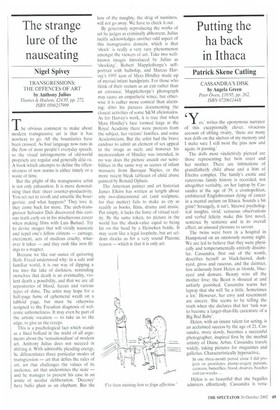TRANSGRESSIONS: THE OFFENCES OF ART by Anthony Julius Thames & Hudson, £24.95, pp. 272, ISBN 0500237999
The obvious comment to make about modern transgressive art is that it has nowhere to go. All the boundaries have been crossed. As foul language now runs in the flow of most people's everyday speech, so the visual infringements of old-world propriety are regular and generally déjà to. A book which attempts to define the offensiveness of new norms is either timely or a waste of time.
But the plight of the transgressive artist is not only exhaustion. It is more demoralising than that: sheer counter-productivity. You set out to revolt and unsettle the bourgeoisie, and what happens? They love it; they come back for more. The arch-transgressor Salvador Dali discovered this curious truth early on in his mischievous career when making films with Luis Bufwel. Try to devise images that will vividly nauseate and repel one's fellow citizens — carnage, excrement, acts of studious cruelty, whatever it takes — and they rush like iron filings to a magnet.
Because we like our ounce of quivering flesh. Freud understood why: in a safe and familiar world, it is our way of dipping a toe into the lake of darkness, reminding ourselves that death is an eventuality, violent death a possibility, and that we are all repositories of blood, faeces and various types of slime. The artist may hope for a half-page fume of ephemeral wrath on a tabloid page, but must be otherwise resigned to the Freudian diagnosis of welcome unhomeliness. It may even be part of the artistic vocation — to take us to the edge, to give us the creeps.
This is a psychological fact which stands as a fixed bollard in the midst of all arguments about the 'sensationalism' of modern art, Anthony Julius does not succeed in shifting it. With admirable pleading energy, he differentiates three particular modes of transgression — art that defies the rules of art, art that challenges the values of its audience. art that undermines the state — and he manages to present his case in an assize of secular deliberation. 'Decency' here bulks plain as an elephant. But the lure of the naughty, the drag of nastiness. will not go away. We have to check it out.
By generously reproducing the works of art he judges as criminally abhorrent, Julius tacitly acknowledges another odd aspect of this transgressive domain, which is that 'shock' is really a very rare phenomenon amongst the viewers of art. Take two wellknown images introduced by Julius as 'shocking', Robert Mapplethorpe's selfportrait with bullwhip, and Marcus Harvey's 1995 icon of Myra Hindley made up of myriad infant handprints. For those who think of their rectum as an exit rather than an entrance. Mapplethorpe's photograph may cause an empathetic wince, but otherwise it is rather more comical than alarming: ditto his pictures documenting the cloacal activities of some S&M aficionados. As for Harvey's work, it is true that when Myra Hindley's face loomed large at the Royal Academy there were protests from the subject, her victims' families, and some Academicians. But the artist had the brave candour to admit an element of sex appeal in the image as such; and however his memorandum of Hindley was intended, in no way does the picture assault our sensibilities in the same way as scenes of infant massacre from Baroque Naples, or the more recent bleak tableaux of child abuse painted by Ronald Ophuis.
The American painter and art historian James Elkins has written at length about why two-dimensional art (and sculpture, for that matter) fails to make us cry as readily as books, films, drama and music. Put simply. it lacks the force of virtual reality. By the same token, no picture in the world has the shock-value equal to being hit on the head by a Heineken bottle. It may seem like a legal loophole, but art seldom shocks us for a very sound Platonic reason — which is that it is only art.


















































































 Previous page
Previous page